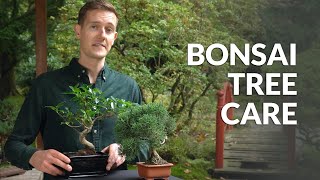Bonsai trees require regular watering, pruning, and sunlight. Consistent attention ensures their health and aesthetic appeal.
Bonsai trees are miniature masterpieces that demand meticulous care. They need consistent watering, proper sunlight, and regular pruning to thrive. Placing them in a suitable location and monitoring their soil moisture is essential. Pruning helps maintain their shape and encourages growth.
Repotting every few years ensures they have enough room for their roots. Fertilizing during the growing season provides necessary nutrients. Bonsai trees also benefit from occasional pest control. These practices ensure your bonsai remains healthy and vibrant. With dedication and attention, a bonsai tree can be a beautiful, long-lasting addition to your home or garden.

Credit: www.ftd.com
Choosing The Right Bonsai
Choosing the right bonsai tree is crucial for its health and beauty. The type of bonsai you select should match your environment and care level. Here, we’ll explore different types and factors to consider.
Types Of Bonsai
There are many types of bonsai trees. Each type has unique needs and styles. Below are some popular options:
- Ficus Bonsai: Easy to care for and great for beginners.
- Juniper Bonsai: Hardy and can be shaped easily.
- Maple Bonsai: Beautiful leaves but needs more attention.
- Chinese Elm Bonsai: Flexible and can grow indoors or outdoors.
Factors To Consider
Several factors affect which bonsai tree is best for you. Consider these points:
| Factor | Description |
|---|---|
| Climate | Choose a tree that suits your local climate. |
| Space | Ensure you have enough space for the bonsai to grow. |
| Light | Some bonsai need more sunlight than others. |
| Time | Consider how much time you can dedicate to care. |
Matching the tree’s needs with your environment ensures its health and longevity. Choose wisely and enjoy the beauty of your bonsai!
Basic Care Requirements
Caring for a bonsai tree can be rewarding. Yet, it requires understanding the basic care requirements. These miniature trees need specific attention to thrive. Below are the essentials you need to focus on.
Watering
Watering a bonsai tree is crucial. The soil should be moist but not soaked. Use a watering can with a fine nozzle. This helps to evenly distribute water. Water the tree until water drains from the pot’s holes. Check the soil daily. If the topsoil feels dry, it’s time to water.
Lighting
Lighting plays a key role in the health of a bonsai tree. Place your bonsai in a spot with plenty of sunlight. Most bonsai trees need about six hours of light daily. If indoor, place it near a south-facing window. Rotate the tree weekly to ensure even light distribution. Artificial lights can supplement natural light, especially in winter.
Pruning Techniques
Pruning is essential to maintaining a healthy bonsai tree. It helps shape the tree and promotes growth. Proper pruning techniques can transform your bonsai into a stunning piece of living art. Let’s dive into the specifics of pruning your bonsai tree.
When To Prune
Timing is crucial for effective pruning. Prune deciduous trees in early spring before new growth starts. Evergreen trees should be pruned in late spring or early summer. Tropical bonsai can be pruned throughout the year.
Regular pruning helps maintain the desired shape and size. Always monitor your tree’s growth patterns. Prune when you see excessive growth or unwanted branches.
Tools Needed
Having the right tools makes pruning easier and more precise. Below is a list of essential tools:
- Pruning shears: For cutting thicker branches.
- Concave cutters: Create clean cuts that heal faster.
- Scissors: For fine trimming of leaves and small branches.
- Wire cutters: Remove training wires without damaging the tree.
Keep your tools clean and sharp. This ensures smooth cuts and prevents infections.
| Tool | Purpose |
|---|---|
| Pruning Shears | Cut thicker branches |
| Concave Cutters | Create clean cuts |
| Scissors | Trim leaves and small branches |
| Wire Cutters | Remove training wires |
Using the right tools helps maintain your bonsai’s health and beauty.
Wiring And Shaping
Wiring and shaping are crucial in bonsai tree care. These techniques help mold the tree into an artistic form. It requires patience and precision.
Wiring Basics
Wiring involves wrapping wires around the branches and trunk. This helps guide their growth. Use aluminum or copper wire for flexibility and strength.
- Choose the right wire thickness.
- Wrap the wire tightly but gently.
- Avoid damaging the bark.
- Monitor the wire regularly.
- Remove the wire before it cuts into the bark.
Common Shapes
Bonsai trees can be shaped into various forms. Here are some popular styles:
- Formal Upright: The trunk is straight and tapered.
- Informal Upright: The trunk has gentle curves.
- Slanting: The trunk leans to one side.
- Cascade: The trunk bends downward below the pot.
- Forest: Multiple trees create a forest scene.
| Style | Characteristics |
|---|---|
| Formal Upright | Straight trunk, balanced branches |
| Informal Upright | Curved trunk, natural look |
| Slanting | Leaning trunk, dynamic appearance |
| Cascade | Downward trunk, waterfall effect |
| Forest | Group of trees, miniature forest |
Wiring and shaping a bonsai tree is an art. With practice, you can create beautiful forms.
Repotting Essentials
Caring for a bonsai tree involves understanding the essentials of repotting. Repotting ensures the tree’s health and growth. It involves changing the soil and giving the roots space to expand. This section covers the basics of repotting your bonsai tree.
When To Repot
Repotting a bonsai tree is crucial for its well-being. The best time to repot is in early spring. During this time, the tree is still dormant but about to enter the growing season. Younger trees may need repotting every 1-2 years. Older trees can go 3-5 years between repotting sessions. Check the roots to see if they are circling the pot. If so, it’s time to repot.
Choosing Soil
The right soil mix is vital for bonsai trees. A good mix ensures proper drainage and nutrient retention. Bonsai soil typically includes a mix of:
- Akadama (clay granules)
- Pumice
- Lava rock
- Organic potting compost
- Fine gravel (grit)
The specific mix can vary based on the tree species. For example, pine trees prefer more akadama, while junipers thrive with more pumice and lava rock. Always ensure the soil is well-draining to prevent root rot.
| Tree Type | Soil Mix |
|---|---|
| Pine | 60% Akadama, 20% Pumice, 20% Lava Rock |
| Juniper | 40% Akadama, 30% Pumice, 30% Lava Rock |
| Maple | 50% Akadama, 25% Pumice, 25% Organic Compost |
Choosing the right soil mix aids in the tree’s overall health. It ensures the tree receives the necessary nutrients and proper drainage.

Credit: www.ftd.com
Fertilization Tips
Fertilizing your bonsai tree is essential. It helps the tree grow strong and stay healthy. Different bonsai species need different types of fertilizers. This guide will help you understand the types and the best application schedule.
Types Of Fertilizer
There are various fertilizers available. Choosing the right one is crucial. Here are some common types:
- Organic Fertilizers: Made from natural materials. They release nutrients slowly. Examples include bone meal and fish emulsion.
- Chemical Fertilizers: These are man-made. They provide nutrients quickly. Examples include NPK fertilizers.
- Liquid Fertilizers: These are easy to apply. Mix them with water. They are absorbed quickly by the roots.
- Pellet Fertilizers: These release nutrients slowly. They are placed on the soil surface.
Application Schedule
The right schedule depends on the season. Here is a simple guide:
| Season | Frequency |
|---|---|
| Spring | Every two weeks |
| Summer | Every two weeks |
| Fall | Once a month |
| Winter | Not required |
Always follow the instructions on the fertilizer package. Over-fertilizing can harm your bonsai tree. Use the right amount for the best results.
Pest And Disease Control
Taking care of a bonsai tree involves more than just watering and pruning. Pest and disease control is crucial for keeping your bonsai healthy. This section covers common pests and preventive measures.
Common Pests
Bonsai trees can attract various pests. Here are some common ones:
- Aphids: Small insects that suck sap from leaves.
- Spider Mites: Tiny pests that form webs on the tree.
- Scale Insects: Hard-shelled bugs that stick to branches.
- Whiteflies: Small, white insects that fly when disturbed.
These pests can weaken your bonsai and make it sick.
Preventive Measures
Preventive measures are essential for keeping your bonsai tree pest-free. Here are some tips:
- Inspect Regularly: Check your bonsai tree for pests every week.
- Clean Leaves: Use a damp cloth to wipe leaves and branches.
- Proper Airflow: Ensure good airflow to prevent pest buildup.
- Natural Predators: Introduce ladybugs to eat harmful pests.
- Neem Oil: Spray neem oil to deter common pests.
Following these steps can help keep your bonsai tree healthy and beautiful.
| Preventive Measure | Details |
|---|---|
| Inspect Regularly | Check for pests every week. |
| Clean Leaves | Use a damp cloth to wipe leaves. |
| Proper Airflow | Ensure good airflow to prevent pests. |
| Natural Predators | Introduce ladybugs to eat pests. |
| Neem Oil | Spray neem oil to deter pests. |
Seasonal Care
Caring for a bonsai tree changes with the seasons. Each season requires different attention. Proper care ensures your bonsai thrives year-round. This section covers essential seasonal care tips.
Winter Care
During winter, bonsai trees need protection from frost. Move your bonsai indoors or to a sheltered area. Ensure they receive indirect sunlight. Water sparingly, as the soil dries slower in winter. Avoid fertilizing during this dormant period.
Check for pests like spider mites. Use a gentle insecticide if needed. Maintain a cool environment, around 50-60°F (10-15°C). Consider using a humidity tray to prevent dry air from harming your tree.
Summer Tips
In summer, bonsai trees require more water. Water daily, ensuring soil stays moist but not soggy. Place your bonsai in a spot with plenty of sunlight. Avoid direct afternoon sun to prevent leaf burn.
Fertilize your bonsai every two weeks. Use a balanced, water-soluble fertilizer. Prune regularly to maintain the tree’s shape. Keep an eye out for pests and treat them promptly.
| Season | Care Tips |
|---|---|
| Winter |
|
| Summer |
|

Credit: www.bonsaiempire.com
Conclusion
Caring for a bonsai tree requires dedication and patience. Regular watering, pruning, and proper sunlight are essential. With consistent attention, your bonsai will thrive and bring beauty to your space. Invest time and enjoy the rewarding experience of nurturing a miniature tree.
Happy bonsai gardening!

